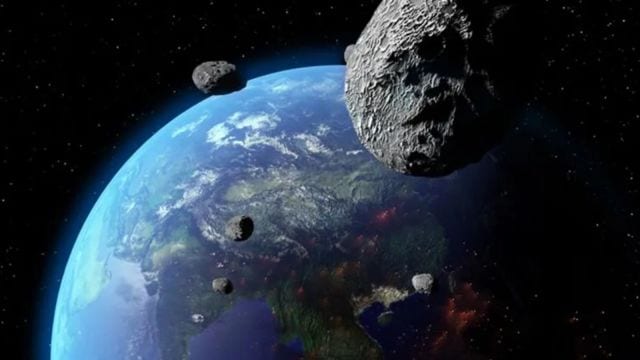The asteroid 2024 MK, discovered on June 16, 2024, underscores the ongoing need to enhance our detection capabilities for potentially hazardous objects in our cosmic neighborhood.
Two asteroids, one discovered earlier in June, passed by Earth this week, coinciding serendipitously with International Asteroid Day, space agencies reported. Both asteroids posed no threat to the planet.
Astrophysicist Gianluca Masi, from The Virtual Telescope Project, provided footage and commentary on asteroid 2024 MK, which has a diameter of around 200 meters. The asteroid came within approximately 300,000 kilometers of Earth, about 77% of the distance to the Moon.
Masi, founder and director of the Bellatrix Astronomical Observatory in Italy, commented during a live YouTube stream at around 2:30 am IST on June 30. He noted that the asteroid was closest to Earth about 10 hours before the live feed.
“It is a huge asteroid coming significantly close to Earth this time, but luckily for us, with no risks at all for our planet,” Masi said.
“Being so close and so large, this object has been very bright at the time of the close approach. If you were in the right part of the world, like the Southwestern Americas, you could see this with modest binoculars,” Masi continued, describing the asteroid fly-by as “exceptional.”
Hurtling at an average speed of nine meters per second, Masi noted that the celestial object was “peculiar” for moving “pretty fast” against the stars.
The fly-by coincided perfectly with International Asteroid Day on June 30, which is supported by the United Nations and commemorates the anniversary of the largest observed asteroid strike in recorded history in 1908. The Tunguska event in Siberia caused an airburst that flattened more than 80 million trees.
Asteroids, often called ‘minor planets,’ are remnants from when the Solar System was formed. There are thought to be about a billion of these irregular-shaped rocky objects orbiting the Sun.
The asteroid 2024 MK, discovered on June 16, 2024, highlights the need to continue improving our ability to detect potentially hazardous objects in our cosmic neighborhood, said the European Space Agency (ESA) in a statement.
The second asteroid, named (415029) 2011 UL21, is the larger of the two that approached Earth this week. Measuring 2.3 kilometers across, it is larger than 99 percent of all known near-Earth objects (NEOs), according to the ESA.
A close approach of an asteroid this size happens on average every 10 years, according to The Virtual Telescope Project.
At its closest to Earth, the asteroid 2011 UL21 was about 6.6 million kilometers away, 177 times the lunar distance, making it a “truly safe encounter,” according to Masi, the commentator for the YouTube livestream on June 27.
The asteroid is also among the top 10 largest to have come within 7.5 million kilometers of Earth since 1900, Masi said. There are an estimated 5 million NEOs larger than 20 meters, the threshold above which an impact could cause ground damage, the ESA said.
As part of its planetary defense projects, the ESA is expected to launch the Hera mission in October 2024. Hera will perform a detailed post-impact survey of the asteroid Dimorphos, which was targeted by NASA’s planetary defense mission on September 26, 2022.
Named the Double Asteroid Redirection Test (DART), NASA’s mission was the first-ever to demonstrate deflecting an asteroid by striking it to change its motion in space. DART hit the 160-meter moonlet Dimorphos, orbiting the larger 780-meter asteroid Didymos, according to NASA’s website.
Chrisphin Karthick, a scientist at the Indian Institute of Astrophysics (IIA) in Bengaluru and involved in the DART mission, told PTI that it was “certainly a step towards” preparing the world for a potential future event like the one believed to have led to the extinction of dinosaurs 66 million years ago.
“We are surrounded by numerous asteroids and comets that orbit our Sun. Very few of them pose a potential hazard to Earth. Therefore, it is prudent to prepare our defenses to avoid any future asteroids on a collision course with Earth,” Karthick said.
